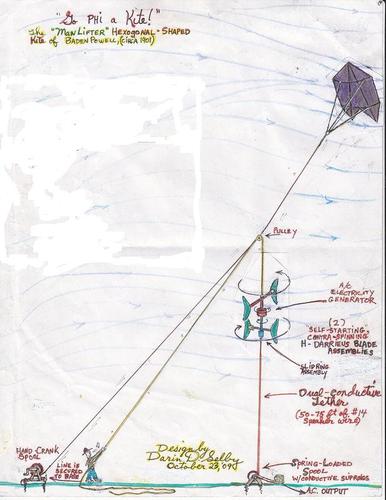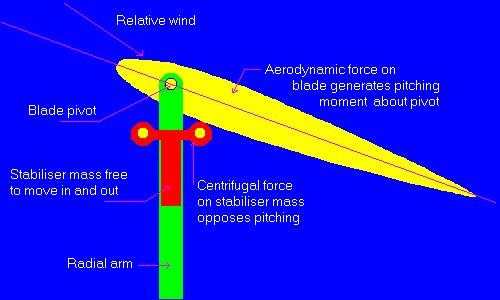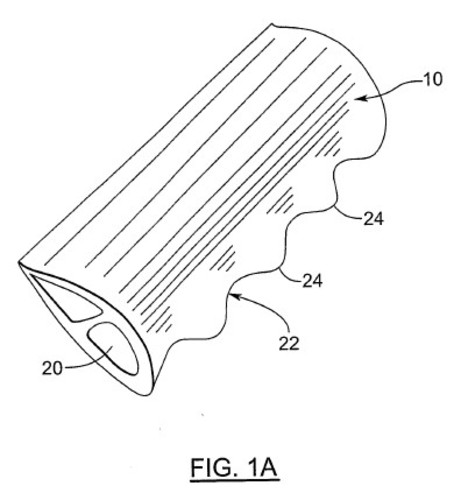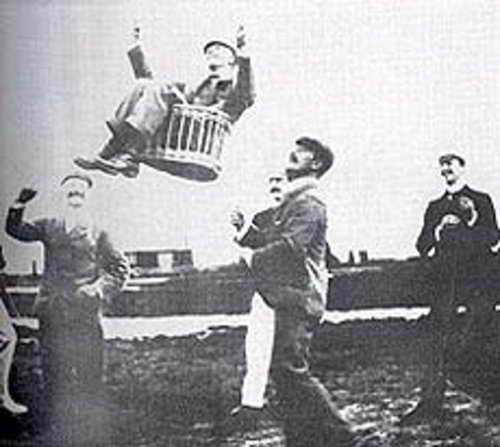Let's Go Phi a Kite!
...and very silently, make an abundance of electricity!
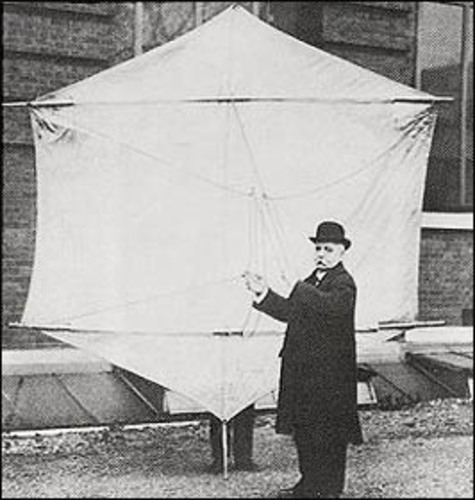
It’s a more practical design for the masses than the Whale's Tail wind energy harvester, which may someday become an art installation at Burningman. This new design utilizes two sets of H-Darrieus rotors, that have only two blades each. Here is some background information on it:
http://en.wikipedia.org/wiki/Darrieus_wind_turbine
Instead of needing an elaborate tower to mount it all on, now it's held aloft by a hexagonal lifter kite:
http://www.cradleofaviation.org/exhibits/dream_of_wings/marconi/
http://www.kites.org/tmr/baden-powell_eng.htm
http://www.kiteplans.org/pln_120/
http://people.zeelandnet.nl/kitepassion/Baden.htm
To assemble this very stable kite, and then send it aloft to only 100-200 feet, would probably take as much effort as setting up the family tent! Then, an abundance of electricity can be made.
By changing the design of the contra-spinning "dual H-Darrieus" rotors to have only two blades per unit instead of three or four, it becomes simpler to assemble, and actually, as I have just discovered, more efficient!
What this wind energy engineer, Doug Selsam,http://www.superturbine.info/, has recently written about, makes a lot of sense. Even though he speaks of propeller blades, I believe that it can also be translated over to H-Darrieus blades as well. Basically, adding more blades than the original two, only leads to more drag:
“I had the veterans telling me how dumb I was to suggest more than 3 blades, per rotor etc., just like beginners do today. I had to listen to the veterans. I remember the day I dropped from 3 blades to 2 per rotor and saw my power increase a LOT. Who knew? I slowly found that the veterans knew a lot that I had no clue of, or just didn't want to believe. One cannot adequately describe the functioning of a high-speed rotor in its power band - it has to be experienced to be believed. (wow!)”
This company, Carbon Concepts, who appear to have a superior design to all other 'Darrieus'-style wind power generators. They do use three blades, but that can easily be edited back to the original 2-bladed system, from the 1921 patent. Though, I do not see that they utilize any "self-starting" mechanism, which is crucial for an efficient H-Darrieus bladed design. They also manufacture their own designed electricity generator. Here is a review made of Carbon Concepts present-day carbon-fiber blade unit:
"Carbon Concepts, UK based designers of lightweight composite structures, have developed a near silent vertical axis turbine for domestic and industrial use.
The vertical axis machines are generically quieter than traditional wind turbines, with the novel design of the blade tips rendering the turbine virtually silent even at the highest speeds.
Most of the functionality of the turbine is based around the use of carbon fibre, a material which has added fatigue resistance, with many other vertical turbines having failed through fatigue in similar aluminium structures, according to the company.
Testing has confirmed that, even at high speed and load, the rotor is effectively silent, and attempts to measure the noise of the rotor showed that perceived noise was dominated by the wind and adjacent trees.
The turbine also has a carbon spar made with glass fibre skins, which is required to keep the fatigue levels below the endurance limit, providing a virtually infinite life.”
They also are set up to fabricate any shape and contour of a blade that one may require. I was studying their present carbon fiber blade design, and it came to mind that the Ultralight trike wing blade shape, that I've come across, may even turn out to be even more efficient. This wing is shaped in such a way as to most likely increase the leading-edge pull, or lift. http://www.carbonconcepts.co.uk/
Then even experiment with attaching bumps on the leading edge of the bladewings. A marine scientist named, Frank Fish, says that it will improve the efficiency of a blade or wing to do so. He learned it from the Humpback whale. And, if whales are doing it, it must be good, eh? There has to be a particular reason why these tubercles, as they're called, exist on the leading edge of their pectoral fins. And, I believe that he has discovered why. http://rexresearch.com/whalewing/whalewing.htm
They migrate over 5100 miles. These boney tubercles (that’s right, they are part of the bone structure), comb the water, to make it more fluidic, and less chaotic, as it flows over the fin. This means that more of an organized slipstream is created. So too, one might as well place this “Whalepower” technology on the leading edge of each carbon fiber, V-wing shaped blade. And then receive up to 30% improvements, according to the tests they’ve done.
As powerfully-efficient as Doug Selsam’s multi-rotor system is,
http://www.superturbine.info/, one needs to also consider having a multi-propeller noise factor, which would be much greater than that of an a multi-unit H-Darrieus system.
This multi-propeller system has props spread out on a relatively horizontal, spinning axle. So in that regard, it needs an elaborate “yawing” rudder fin, to stay pointed into the right wind direction. The simpler, H-Darrieus assemblies will continue to spin, no matter what direction the wind is coming from.
Granted, it may not even be close to producing the same amount of power-output of this multi-propeller system, yet the trade-off would be in its quietness and portability.
Four detachable Carbon fiber V-shaped bladewings, and two rotating hubs, with an electricity generator in-between, with a "slipring assembly" below it.
http://www.tradeindia.com/Seller-1964440-2421458-1023-CATALOGS/Machinery-Parts/AARCO-INDIA.html
The other advantage is that these “contra-spinning”, H-Darrieus assemblies can be vertically-stacked in numbers, while hanging beneath the kite string pulley! The constant tug from the spring-loaded spool reel (minus its "catch" mechanism), is fastened below to the ground.
http://www.northerntool.com/webapp/wcs/stores/servlet/product_6970_200326536_200326536
This spring-loaded spool may be located about 100 feet away from where the trailer-mounted kite tether, hand-crank spool is located.
I would also venture to say that, having vertical-spinning, carbon-fiber blades would be more benign to flying creatures. As these units get larger, the chaos vortex turbulences also have to be accounted for. There is already trouble with bats’ lungs exploding, from flying in the downwind vicinity of a wind farm
Erin Baerwald of the University of Calgary in Canada. "An atmospheric-pressure drop at wind-turbine blades is an undetectable-and potentially unforeseeable-hazard for bats, thus partially explaining the large number of bat fatalities at these specific structures.
"Given that bats are more susceptible to barotrauma than birds, and that bat fatalities at wind turbines far outnumber bird fatalities at most sites, wildlife fatalities at wind turbines are now a bat issue, not a bird issue. http://www.ucalgary.ca/news/aug2008/batdeaths
Multiple spinning blades will cause a smaller, yet more concentrated, trailing vortex street. http://en.wikipedia.org/wiki/Kármán_vortex_street This means that a more concentrated area of low pressure turbulence, is created. To maximise its efficiency, and capture the “fresh wind”, these many spinning blades are tilted, upon its one long spinning axle. So, the area of downstream chaos vortex turbulence is magnified upon that one horizontal axis. http://www.speakerfactory.net/Truss.jpg
Stacked H-Darrieus, contra-spinning units, would tend to spread its downstream chaos vortex turbulence along a vertical axis. This means less of a concentrated, low pressure zone in one area. This is better for the bats, and preventing the barotrauma from happening.
Is it really about making greater wattage than the next guy’s design, or is it more about efficiently utilizing the amount of decentralized power that is being created? That is, having highly-efficient appliances, which are used on a daily basis (i.e. refrigerator, lighting, computer, water pumps, electric vehicle). This upgrade to appliances that use micro-power, could offset a lower wattage output of this not-as-powerful, yet more benign, wind energy harvesting system.
^This shows the ability of the Baden-Powell "manlifter" hexagonal kite to do just that! And, if it can do this, it can surely lift, and steadily hold the contra-spinning H-Darrieus unit, in place!
http://darinselby.1hwy.com/whalestailwindenergyharvestr.html
